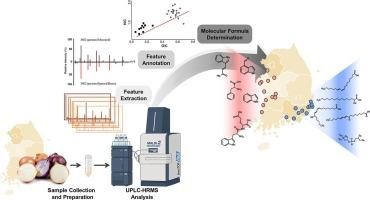通过非靶向代谢组学和化学计量学分析揭示了韩国种植的洋葱(Allium cepa)的地理分化
IF 9.8
1区 农林科学
Q1 CHEMISTRY, APPLIED
引用次数: 0
摘要
洋葱(Allium cepa)在韩国广泛种植,但区域特异性代谢组学特征仍未得到充分研究。为了解决这一空白,我们使用ulc - tims - qtof ms对56个栽培地点收集的洋葱乙醇提取物进行了非靶向代谢组学分析,分析发现了2339个(阳性模式)和1350个(阴性模式)分子特征,其中242个化合物通过光谱库匹配进行了注释。为了将覆盖范围扩大到有限的注释分数之外,精确的基于质量的分子式预测确定了1992个独特的分子式,随后用于分子分类和指数分析。多变量聚类结果显示,洋葱可分为中-西南(CSW)和东南(SE)两种化学型,东南(SE)洋葱富含脂质样代谢物,H/C比值较高,而东南(CSW)洋葱含有较多的吲哚和有机杂环化合物,AImod和DBE值升高。网络分析进一步强调了抗氧化和抗炎代谢物的区域特异性富集。尽管存在这些区域差异,槲皮素和山奈酚衍生物等酚类苷在所有样品中都一致丰富。总的来说,这些发现扩大了对韩国洋葱代谢组多样性的认识,并证明了代谢组指纹图谱在营养评价和地理来源认证方面的潜力。本文章由计算机程序翻译,如有差异,请以英文原文为准。


Geographical differentiation of onions (Allium cepa) cultivated in South Korea revealed by untargeted metabolomics and chemometric analysis
Onions (Allium cepa) are widely cultivated in South Korea, yet region-specific metabolomic profiles remain underexplored. To address this gap, we conducted untargeted metabolomic profiling of ethanol extracts from onions collected at 56 cultivation sites using UPLC-TIMS-QTOF MS. The analysis detected 2339 (positive mode) and 1350 (negative mode) molecular features, among which 242 compounds were annotated through spectral library matching. To extend coverage beyond the limited annotated fraction, accurate mass-based formula prediction identified 1992 unique molecular formulas, which were subsequently used for molecular classification and index analysis. Multivariate clustering revealed consistent separation into Central–Southwestern (CSW) and Southeastern (SE) chemotypes, with SE onions enriched in lipid-like metabolites and higher H/C ratios, while CSW onions contained more indoles and organoheterocyclic compounds with elevated AImod and DBE values. Network analysis further highlighted region-specific enrichment of antioxidant and anti-inflammatory metabolites. Despite these regional differences, phenolic glycosides such as quercetin and kaempferol derivatives were consistently abundant across all samples. Collectively, these findings expand knowledge of onion metabolome diversity in South Korea and demonstrate the potential of metabolomic fingerprinting for both nutraceutical evaluation and geographical origin authentication.
求助全文
通过发布文献求助,成功后即可免费获取论文全文。
去求助
来源期刊

Food Chemistry
工程技术-食品科技
CiteScore
16.30
自引率
10.20%
发文量
3130
审稿时长
122 days
期刊介绍:
Food Chemistry publishes original research papers dealing with the advancement of the chemistry and biochemistry of foods or the analytical methods/ approach used. All papers should focus on the novelty of the research carried out.
 求助内容:
求助内容: 应助结果提醒方式:
应助结果提醒方式:


